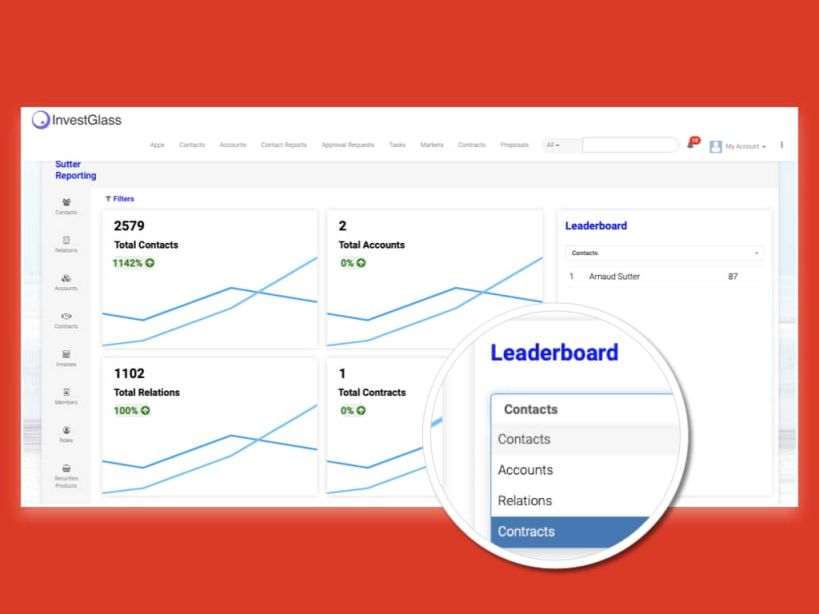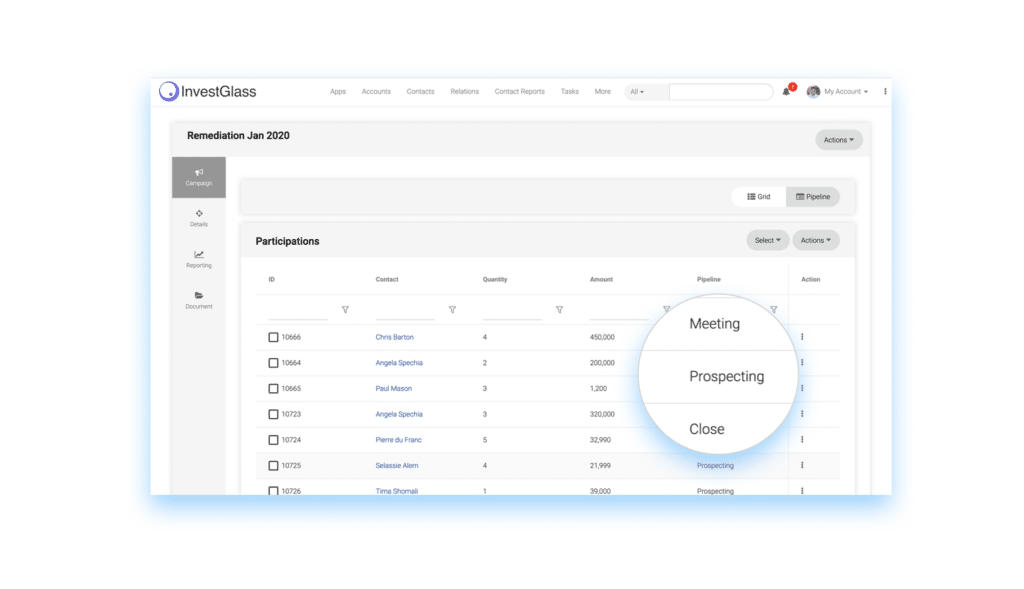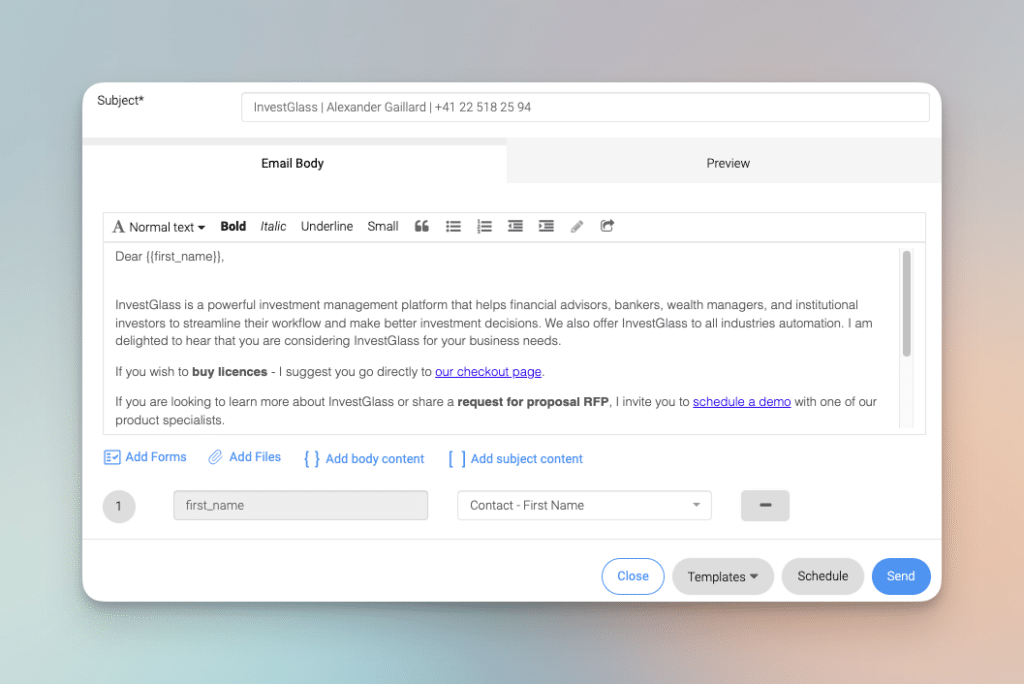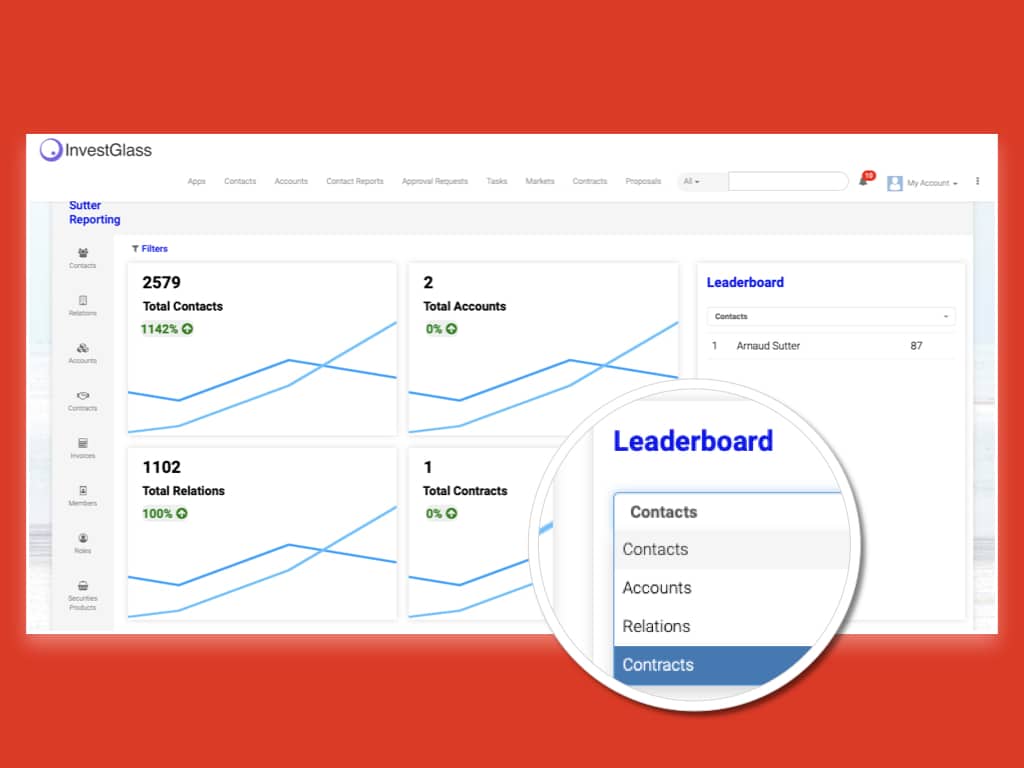Maximize Your Strategy: Top B2B Marketing 5 Best Practices for Success

Tired of guesswork in your B2B marketing? High-performing businesses follow specific patterns for success. Discover the b2b marketing 5 best practices that are game changers in a competitive marketplace, guiding you to harness data, tailor communication, optimize interaction, align teams, and engage on leverage social media platforms. Start elevating your B2B marketing now with these targeted strategies.
InvestGlass is a unique CRM built to find target buyers thanks to IA and chat gpt. Artificial intelligence is used for marketing activity, decision stage process, lead generation, connection with marketing team, brand loyalty, revenue growth process, generating personalized content, marketing content and driving account managers to success!

The buying process is setup with InvestGlass’s powerful pipeline and reason tools. Those tools are built to help you win and understand also what are triggering lost customers. The customer relationships is unique as it is a NON-US tool which is not obeying to the Cloud Act.
Key Takeaways
- Data-driven decision-making powered by predictive analytics and overcoming silo challenges is critical for effective B2B marketing strategies, enabling businesses to make informed decisions, create targeted campaigns, and adapt to market trends.
- Personalized B2B marketing across various channels improves customer experience and engagement, with consistency and channel-specific strategies being key drivers for achieving impactful communication and brand trust.
- Interactive content significantly increases B2B engagement and helps personalize marketing efforts, with quizzes, polls, interactive infographics, and videos among the types of content that draw more user interaction.
Data-Driven Decision Making

In the current digital marketing sphere, data isn’t merely a buzzword–it forms the bedrock of successful strategies. Nearly 69% of B2B companies rely on data for strategic direction, illustrating its pivotal role. Instead of relying on intuition, businesses now unlock their value proposition through data-driven decisions.
Measuring return on investment (ROI) and analyzing performance indicators such as campaign effectiveness and Key Performance Indicators (KPIs) are vital practices in this process. A focus on data facilitates the creation of intricate buyer personas and assists in audience segmentation, leading to more pertinent and targeted, marketing activities. However, the influence of data extends beyond the decision-making stage.
Indeed, data retains its significance post-purchase. Regular data analysis allows marketers to modify strategies to match market trends, boost competitive agility, and utilise high-quality data for impactful campaigns. So, how can we optimally utilise available data? The key lies in harnessing predictive analytics and conquering silo challenges.
The Role of Predictive Analytics
Predictive analytics revolutionizes B2B marketing. It identifies trends, enabling marketers to implement data-driven strategies, thereby optimizing marketing efforts for superior outcomes. This advanced analytics tool goes further. It aids proactive risk management by identifying potential risks early, setting the stage for the development of effective mitigation strategies.
The fusion of Artificial Intelligence (AI) with predictive analytics in the past few years has elevated awareness stage the tool’s potential. Deeper data analysis, detection of complex patterns, and enhanced predictions through machine learning have become a reality, transforming the way marketers strategize. However, akin to any transformative technology, AI-driven predictive analytics brings its own challenges.
Data privacy concerns, technical integration issues, and the need for a learning-oriented culture among employees are some of the key challenges that need to be addressed. Overcoming these challenges is crucial in unlocking the full potential of predictive analytics in guiding data-driven decision-making.
Overcoming Silo Challenges
Data silos pose a significant challenge for many organizations. These groups of data, isolated from the rest of an organization, can cause transparency, efficiency, and trust issues within departments. Data silos often emerge from technological issues, rapid organizational growth, decentralized IT services, and intra-organizational competitiveness. The impact of data silos can be far-reaching, resulting in inconsistencies in reports and uncertainty about the metrics used across different teams.
Recognizing the presence of data silos and dismantling them is crucial for any organization aiming to achieve a high-quality, integrated database. Solutions such as:
- iPaaS
- Adopting all-in-one platforms
- Leveraging applications with native integrations
- Fostering a collaborative culture
- Cleansing outdated data
By preventing data silos, organizations can maintain a rich, integrated database enriched by applications used throughout the organization.
In conclusion, data-driven decision making, powered by predictive analytics and free from silo challenges, forms the backbone of a successful B2B marketing strategy. However, data alone isn’t enough. The content delivered to potential customers must be personalized across channels for maximum impact.
Personalization Across Channels
In a time when consumers are inundated with marketing messages, personalization emerges as a potent tool to stand out. This is particularly true in business to business (B2B) marketing, where personalization responds to specific business needs and interests of individual consumers, making it an effective strategy. With 82% of business buyers expecting experiences similar to retail or business to consumer buying, the demand for personalized B2B interactions is skyrocketing.
Data underpins the personalization of content and offers, enhancing overall customer experiences and pinpoint targeting. Knowing the audience, including their demographics and preferred social platforms, is essential for creating targeted and engaging content. Personalized ad campaigns used in B2B marketing lead to improved customer experience, better lead generation, and enhanced customer retention. How can we attain such a degree of personalization across various channels? The solution lies in ensuring consistency and executing channel-specific strategies.
Importance of Consistency
Delivering a seamless experience to potential buyers is crucial in the B2B world. Consistency in marketing is a key factor in building trust and brand awareness. Whether it’s a social media post or an email campaign, every piece of content released should speak in the brand’s voice and represent its values.
To ensure that messaging is consistent across various marketing channels, all teams involved in content creation should collaborate closely. By consistently conveying the brand’s narrative and value proposition across all channels, companies can effectively personalize the customer journey and enhance engagement. But consistency is just one piece of the puzzle. To maximize the impact of your marketing efforts, it’s important to implement channel-specific strategies such as:
- Creating compelling visuals for social media platforms
- Optimizing website content for search engines
- Utilizing email marketing to nurture leads
- Implementing targeted marketing campaigns
- Engaging with customers through live chat or chatbots
By tailoring your strategies to each channel, you can effectively reach and engage your own target market and audience.
Channel-Specific Strategies
Selecting the appropriate marketing strategy for each channel is a crucial aspect of successful B2B marketing. For example, in B2B email marketing, personalization significantly increases click-through rates by 14% and conversions by 10% when emails are tailored to the individual.
Effective B2B email marketing practices include using subject lines ranging from 28 to 50 characters, keeping the email body text between 50 to 125 words, maintaining a conversational tone, and incorporating 1 to 3 images to optimize engagement. B2B email content should be structured around answering what is offered, how it helps the recipient, and what the next steps are, with a recommended sending frequency of 1 to 5 emails per month.

Incorporating interactive video content, such as live webinars through platforms like Zoom or GoToWebinar, is another strategic approach to enhance B2B video marketing. Active audience participation and increased brand visibility on channels like YouTube can significantly boost engagement. Personalization across channels, backed by consistency and channel-specific strategies, can significantly enhance your brand’s impact.
However, to further drive engagement, interactive content plays a pivotal role.
Interactive Content for Engagement

Interactive content has surfaced as a formidable tool in the B2B marketing toolkit. With marketing professionals predicting an increased focus on interactive content, with a projected allocation of 14% of marketing budgets in 2023, it’s clear that interactive content is here to stay. What precisely renders interactive content so impactful?
Interactive content such as quizzes, surveys, and polls leads to higher engagement, with a 52.6% increase over static content, and users spending more time interacting with it. This type of content facilitates more personalized marketing and communication efforts, essential for lead nurturing and customer acquisition across different stages of the sales funnel.
Interactive infographics, interactive emails, and chatbots are among the most effective types of interactive content, with significant usage by brands and high engagement rates from audiences. Approximately 86% of buyers show a preference for interactive content that can be accessed on demand, with interactive videos being notably favored for engagement. To harness the influence of interactive content, comprehending the various types and their effective creation is vital.
Types of Interactive Content
Interactive content is a broad category, including:
- Quizzes
- Interactive infographics
- Image sliders
- Interactive films
Quizzes can be both fun and shareable, increasing engagement among B2B audiences. Interactive infographics enhance the visualization of data with interactive elements, making the content stand out.
Image sliders enable a straightforward comparison of images, while interactive maps allow users to engage with various locations, both adding to user engagement. Interactive films and videos, which allow user input to control outcomes, provide a unique and engaging content experience for users. But creating effective interactive content requires careful planning and execution, which brings us to the best practices for creating interactive content.
Best Practices for Creating Interactive Content
Creating effective interactive content starts with understanding your target audience. To resonate with them, it’s essential to know their preferences and which types of interactive content engage them the most. However, creating interactive content requires careful planning of budget and resources due to its typically greater demand in time and money, in addition to understanding the technicalities of integrating such content over static alternatives.
Developing a content strategy that incorporates interactive content can give your business a competitive edge and lead to measurable outcomes in engagement and client relationships. Interactive content, when used effectively, can significantly boost engagement and personalize marketing efforts. However, to fully capitalize on these content marketing strategies, sales and marketing teams must be aligned.
Sales and Marketing Alignment

The harmonization of sales teams and marketing teams is pivotal for a successful B2B marketing strategy. A well-coordinated marketing team must collaborate with the sales team to:
- Create content that supports every stage of the buyer’s journey
- Provide value beyond mere traffic generation or keyword ranking
- Marketing can support the sales team by producing content that resonates with potential buyers
- Integrating sales insights and messaging into content strategies.
In the B2B buyer’s journey, there are three core stages: awareness, the consideration stage, and decision. Each of these stages requires tailored content from sales and marketing teams. Thought leadership marketing, which builds trust, increases the value of offerings, enhances brand awareness, and intensifies brand PR, plays a critical role in B2B marketing alignment. To guarantee this alignment, recognizing customer needs and cultivating team collaboration is indispensable throughout the entire buyer journey.
Identifying Customer Needs
Understanding customer needs is key to successful B2B marketing. Common B2B customer pain points include:
- Financial constraints
- Operational inefficiencies
- Technical difficulties
- Personalization needs
- Security concerns
- Regulatory compliance
- Competitive pressures
- Innovation challenges
- Scalability requirements
- Cultural or organizational misalignments
To identify these pain points, salespeople should do market research and ask insightful questions about:
- industry challenges
- time-consuming tasks
- business improvement priorities
- existing solutions to challenges
Actively listening to customer responses and asking follow-up questions enable sales reps to gain a comprehensive understanding of customer pain points. Guided selling experiences can simulate an in-store experience online, assisting B2B customers in identifying their needs and guiding them through the purchase process customers often find challenging, ultimately leading them to the appropriate product or solution.
Understanding customers’ pain points in B2B marketing is crucial for providing valuable solutions and enhancing the targeted marketing strategy. But identifying customer needs is just the first step. Collaboration between sales and marketing is crucial to ensure that these insights are effectively integrated into the marketing strategy.
Collaboration Techniques
Cultivating cooperation between sales and marketing teams is vital for successful B2B marketing. Brand guidelines, which define messaging, imagery, tone, and other elements, ensure all communications are aligned and must be regularly monitored and updated to adapt to business evolution while maintaining consistency. Employee training on brand guidelines is critical to ensure that all staff members represent the brand consistently across channels and interactions, ultimately fostering brand loyalty.
To foster collaboration between marketing and sales, consider implementing the following strategies:
- Develop a shared sense of purpose and mutual respect.
- Create a Service Level Agreement (SLA) to define roles and set Key Performance Indicators (KPIs).
- Schedule regular check-ins and meetings between sales and marketing teams for open communication, data exchange, and alignment of goals and strategies.
- Streamline processes and leverage technology, such as Customer Relationship Management (CRM) and marketing automation tools, to enhance collaboration between marketing and sales.

Continuous improvement is supported by a culture of feedback, allowing teams to learn from each other and adapt strategies for better customer experiences. Measuring and analyzing shared KPIs is crucial for both teams to understand the effectiveness of their strategies and make necessary adjustments. Sales and marketing alignment, coupled with a strong social media strategy, can significantly enhance your B2B marketing efforts.
Social Media as a Conversation Tool

In today’s digital world, social media transcends being a mere content-sharing platform—it evolves into a compelling conversation tool. Social media should be used as a conversational selling platform in B2B marketing, enabling valuable and relevant interactions with the audience. Continued leveraging of social media is essential for B2B marketers to interact with key target audiences, form durable relationships, and establish trust.
Social media giveaways and contests boost follower engagement with 65% of participants considering them effective, and contests are responsible for 34% of new customer acquisitions. Interactive conversations on social media foster a more personal connection with users, improving their understanding of products or services. To interact effectively with your audience on your social media channels, selecting the appropriate platforms is essential.
Choosing the Right Platforms
Selecting the right social media platforms for your B2B marketing efforts is critical for success. LinkedIn is the leading platform for generating B2B leads, with 80% of B2B leads sourced from social media coming from LinkedIn. Twitter is utilized by 59% of B2B businesses for its real-time conversation capabilities and thought leadership opportunities.
Facebook’s advanced targeting features and extensive audience base make it a valuable platform for B2B marketers aiming to engage with potential customers based on specific interests. Instagram’s emphasis on visuals helps B2B marketers develop a strong visual brand identity and effectively promote company culture and events.
Selecting the right platforms is merely the beginning. Constructing an engaging social media presence is fundamental to amplifying the effect of your social media marketing initiatives.
Building an Engaging Social Media Presence
Constructing an engaging social media presence merges art with science. Buyers trust individual voices more than formal marketing and advertising messages, which makes optimizing influence internally a key focus area in B2B marketing. Incorporating influencer marketing into this strategy can help establish a brand as a trusted expert in its field, with consistent branding across social media platforms and other touchpoints.
Using tools like content calendars ensures a strategic mix of promotional and value-adding content and helps in maintaining regular posting schedules. Some tips for creating engaging and relevant content on social media include:
- Tailoring content to specific social media platforms, like Adobe does on TikTok
- Incorporating humor that resonates with the industry audience
- Using interactive games to increase engagement and foster community on social media.
These strategies can enhance audience connection and increase brand awareness and relevance on social media, while also improving search engine optimization.
Humanizing the brand through features like employee stories and achievements adds a personal touch and relatability to B2B social media profiles. Promptly responding to comments and direct messages on social media leads to better customer relationships and more effective lead generation. Social media, when used effectively as a conversation tool, can significantly boost your B2B marketing efforts.
Summary
In today’s dynamic B2B marketing landscape, data-driven decision making, personalization across channels, interactive content for engagement, sales and marketing alignment, and effective use of social media as a conversation tool are key to success for successful marketers. These best practices, when implemented strategically, can significantly boost your marketing efforts, leading to better customer engagement, higher conversion rates, and improved customer retention.
B2B marketing is not a one-size-fits-all approach. It requires a deep understanding of your audience, a strategic use of data, and the ability to adapt to changing market trends. The journey to B2B marketing success is a continuous process of learning, experimenting, and refining your strategies. Are you ready to take your B2B and marketing plan to the next level?
Frequently Asked Questions
What are the 7 P’s of B2B marketing?
The 7 P’s of B2B marketing are Product, Price, Place, Promotion, People, Process, and Physical evidence. These elements can contribute to achieving effective marketing strategy and goals for businesses.
What are the 4 pillars of B2B marketing?
The 4 pillars of B2B marketing are Insight, Strategy, Creative, and Metrics, which are crucial for the success of any B2B campaign. Each pillar plays a vital role in supporting the campaign, both online and in print.
What is the 95 5 rule for B2B?
The 95:5 rule in B2B marketing advises focusing 95% of your efforts on educating, providing value, and building relationships with business customers, and only allocating 5% to direct promotion. This approach emphasizes relationship-building over direct promotion.
What are the best practices for B2B marketing?
Utilize 12 effective B2B marketing strategies to optimize your marketing efforts, generate leads and drive business growth.
Why is data-driven decision making important in B2B marketing?
Data-driven decision making is important in B2B marketing because it allows you to measure ROI, analyze performance indicators, create detailed buyer personas, and adjust strategies based on market trends. This helps guide marketing strategies effectively.